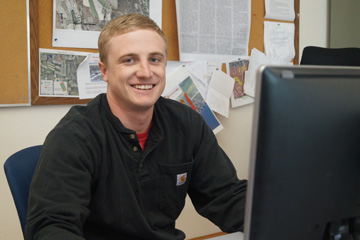
05/19/2015
When people think about drones or other unmanned aircraft, they tend to picture robot planes on military or espionage missions.
Garrett Smith ’15 pictures his future.
Smith graduated from SUNY Cortland May 16 with specialized training in geographic information systems (GIS), an entrepreneurial spirit and a business plan to help farmers and other large property owners look at their land through a new set of eyes.
The 26-year-old former automotive technician and four friends — two of them recent SUNY Cortland graduates — are set to start their own business using unmanned aerial vehicles (UAVs), devices similar to drones, to collect valuable agricultural and environmental data for businesses.
“I said to them: ‘Guys, let’s just hit the ground running after graduation,’” said Smith, a native of West Bloomfield, N.Y.
Fellow GIS major Peter Hyland and communication studies majors Christopher Gulino ’15 and Nicholas Marrone ’15 will join his venture. So will friend Daniel Graef. The group will spend the summer near Smith’s hometown, on Canandaigua Lake, looking to assist businesses in the Finger Lakes region.
“We want our bread and butter to be agriculture, golf courses and wineries,” Smith said.
UAVs can capture images from the sky using light wavelengths that the human eye can’t detect by itself. They provide crucial information such as crop yield and land health with simplicity and ease.
“It’s all about the speed and efficiency they afford,” said Smith.
Farmers can count crops on their own just like a homeowner can mow his or her own lawn, he said. However, a farmer with hundreds or thousands of acres to manage likely would welcome a reliable way to perform the task, just like a homeowner with plenty of yard space might prefer a lawn mowing service to save time and energy.
“Every single day, UAV mapping leads to another application,” Smith said. “You can collect data for search and rescue, geology mining, oil and gas, forestry … everything.”
The idea to start his own business evolved during Smith’s senior year job search. He contacted a small UAV technology company about ways to join its team. He mentioned his eventual goal was to start his own business doing GIS work. The company encouraged him to use its product.
Smith went from job seeker to client in an attempt to speed up his dream.
“I’m trying to predict the future in a way,” he said. “Some people might think I’m crazy, but I don’t mind.”
Smith already has proven his resilience. After graduating from high school in 2007, he pursued automotive technology training from Monroe Community College (MCC) and found steady work at a car dealership. But a dirt biking accident in 2011 left him with several broken bones in his face and lingering effects from a concussion. He struggled to remember how to spell words.
“The neurologist recommended I go back to school to re-learn a lot of things from before the accident,” he said. “He told me to exercise my brain.
“I chose business because it’s broad.”
Smith went back to MCC for an associate’s degree in business administration and fell in love with a course on digital imaging of the earth during his final semester there. His instructor suggested continuing his education at SUNY Cortland, one of the only institutions in the SUNY system that offers GIS as a major.
“We knew Garrett was special when we first met him,” said Wendy Miller, a SUNY Cortland associate professor of geography. “His enthusiasm, curiosity and thirst for knowledge are infectious.
“And he has so many good ideas of what could be done with GIS and what he wants to do with his future … I cannot wait to see what happens next for him”
During his time at the College, Smith also worked with the City of Cortland Fire Department to explain the benefits that GIS technology can bring to fire hydrant and water line mapping. He presented at a City Council meeting in February about the services his SUNY Cortland classmates could provide as interns.
And he hopes his own business can employ the College’s students in the future.
“There are so many resources right here (on campus) to do some pretty cool things,” he said. “The College is so close and we’re already one of the best schools in the field.”